
Fire corals (Millepora) are a genus of colonial marine organisms that exhibit physical characteristics similar to that of coral. The name coral is somewhat misleading, as fire corals are not true corals but are instead more closely related to Hydra and other hydrozoans, making them hydrocorals. They make up the only genus in the monotypic family Milleporidae.

The giant moray is a species of moray eel and a species of marine fish in the family Muraenidae. In terms of body mass, it is the largest moray eel; however, the slender giant moray is the largest in terms of body length.
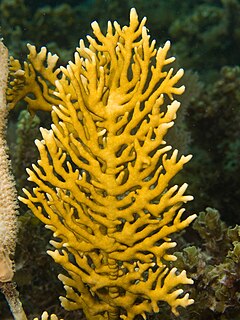
Millepora alcicornis, or sea ginger, is a species of colonial fire coral with a calcareous skeleton. It is found on shallow water coral reefs in the tropical west Atlantic Ocean. It shows a variety of different morphologies depending on its location. It feeds on plankton and derives part of its energy requirements from microalgae found within its tissues. It is an important member of the reef building community and subject to the same threats as other corals. It can cause painful stings to unwary divers.

Acropora aspera is a species of staghorn coral in the family Acroporidae. It is found on reef flats and in lagoons in very shallow water in the western Indo-Pacific Ocean.
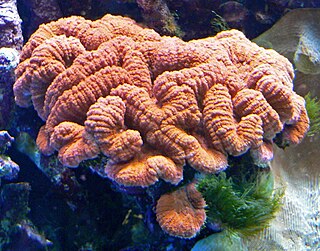
Lobophyllia hemprichii, commonly called lobed brain coral, lobed cactus coral or largebrain root coral, is a species of large polyp stony coral in the family Lobophylliidae. It is found in the Indo-Pacific Ocean. In its specific name Christian Gottfried Ehrenberg honoured his late partner the Prussian naturalist Wilhelm Hemprich; they were among the first to study the marine life of the Red Sea.

Acropora millepora is a species of branching stony coral native to the western Indo-Pacific where it is found in shallow water from the east coast of Africa to the coasts of Japan and Australia.

Acropora muricata, commonly called staghorn coral, is a species of acroporid coral found in the Gulf of Aden, the Red Sea, Indian Ocean, Persian Gulf, Australia, central Indo-Pacific, Japan, Southeast Asia, the East China Sea and the oceanic central and western Pacific Ocean. It is found in tropical shallow reefs, slopes of reefs, and in lagoons, from depths of 5 to 30 m. It was described by Dana in 1846.

Montipora aequituberculata is a species of stony coral in the family Acroporidae. It is a common coral in shallow water in the Indo-Pacific region.

Turbinaria mesenterina, commonly known as disc coral, is a species of colonial stony coral in the family Dendrophylliidae. It is native to the Indo-Pacific region. The International Union for Conservation of Nature has rated its conservation status as being "vulnerable".

Turbinaria bifrons, commonly known as disc coral, is a species of colonial stony coral in the family Dendrophylliidae. It is native to the Indo-Pacific region. It is a zooxanthellate coral that houses symbiont dinoflagellates in its tissues. This is an uncommon species and the International Union for Conservation of Nature has rated its conservation status as being "vulnerable".
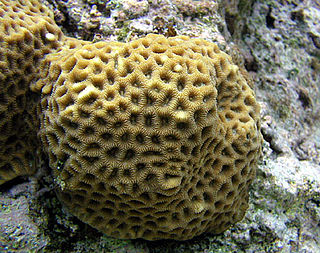
Favites abdita, also known as the larger star coral, is a species of stony coral in the family Merulinidae. It is native to the Indo-Pacific region and its range extends from East Africa and the Red Sea through the Indian Ocean to the Western Pacific Ocean. The International Union for Conservation of Nature has rated its conservation status as being "near-threatened".

Herpolitha is a monotypic genus of mushroom corals in the family Fungiidae. The only member of the genus is Herpolitha limax, commonly known as the tongue, slipper, mole or striate boomerang coral. It is a free-living species and is native to reefs and lagoons in the Indo-Pacific region. The International Union for Conservation of Nature has assessed this coral as being of "least concern".

Coelastrea aspera is a species of stony coral in the family Merulinidae. It is a colonial species native to the Indo-Pacific region where it occurs in shallow water. It was first described by the American zoologist Addison Emery Verrill in 1866 as Goniastrea aspera but it has since been determined that it should be in a different genus and its scientific name has been changed to Coelastrea aspera. This is a common species throughout much of its wide range and the International Union for Conservation of Nature has rated its conservation status as being of "least concern".

Oulophyllia crispa, sometimes called the intermediate valley coral, is a species of stony coral in the family Merulinidae. It is native to the tropical western and central Indo-Pacific region. Although this coral has a wide range, it is generally uncommon and seems to be decreasing in abundance, and the International Union for Conservation of Nature has rated its conservation status as being "near threatened".

Blastomussa merleti, commonly known as pineapple coral, is a species of large polyp stony coral. It is unclear in which family the genus Blastomussa belongs. This coral is native to the west and central Indo-Pacific region and is sometimes used in reef aquaria.

Millepora complanata, commonly known as blade fire coral, is a species of fire coral in the family Milleporidae. It is found in shallow waters in the Caribbean Sea where it is a common species. The International Union for Conservation of Nature has assessed its conservation status as being of "least concern".
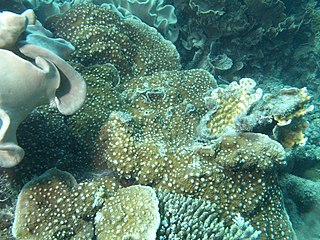
Oxypora lacera, the ragged chalice coral or porous lettuce coral, is a species of large polyp stony corals in the family Lobophylliidae. It is a colonial coral which can be submassive, encrusting or laminar. It is native to the western Indo-Pacific.
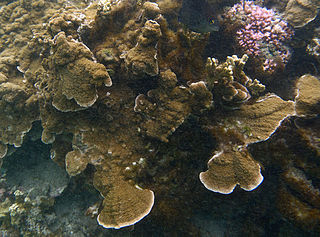
Echinophyllia aspera, commonly known as the chalice coral, is a species of large polyp stony corals in the family Lobophylliidae. It is a colonial coral which is partly encrusting and partly forms laminate plates or tiers. It is native to the western and central Indo-Pacific.
Anacropora forbesi is a species of briar coral that can be found in the tropical western and central Indo-Pacific region. It is the type species of the genus Anacropora.
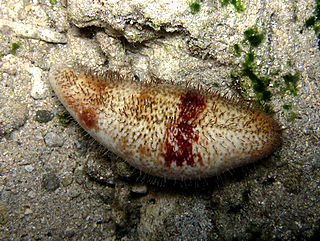
Actinopyga capillata, the hairy sea cucumber, is a species of sea cucumber in the family Holothuriidae. It is found in the tropical West Indo-Pacific region, having a disjunct range, with the main population in island groups in the western Indian Ocean, and a separate population in the Philippines.




















